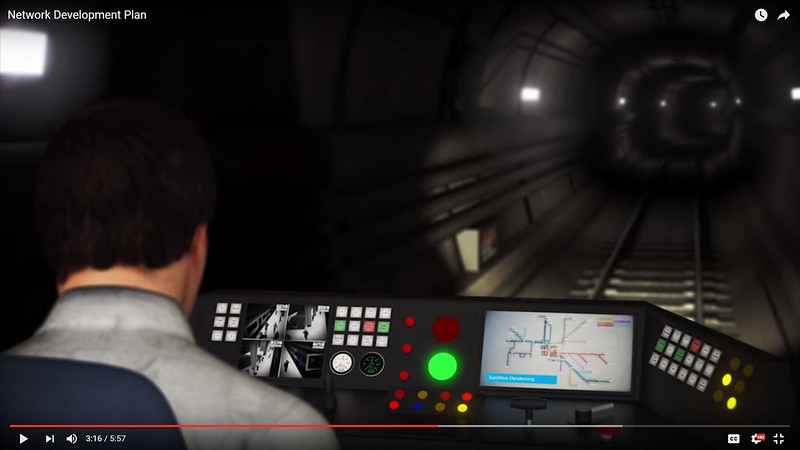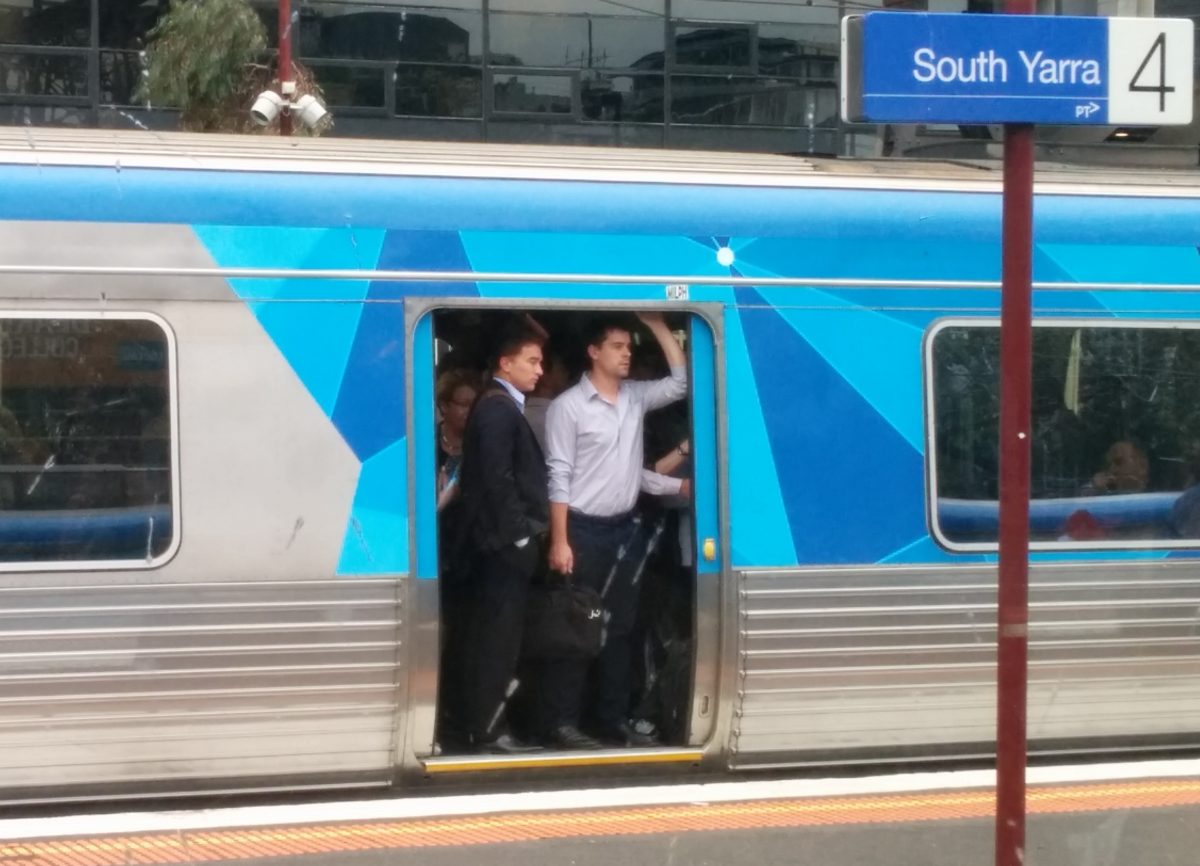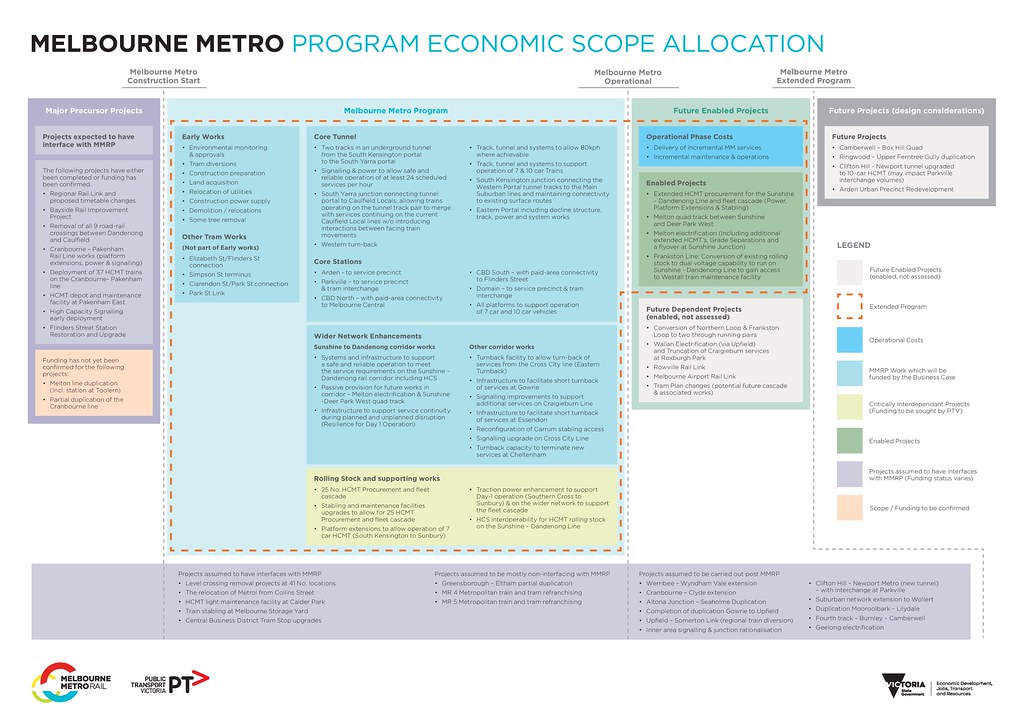Last Thursday the state government announced more details around the Metro rail tunnel, and related projects.
High Capacity Signalling
Upgrading existing rail lines to High Capacity Signalling (HCS) has the potential to boost track capacity by up to about 50%, though to reach that, you would need to remove level crossings too.
Originally HCS was to have been trialled on the Sandringham line. The Napthine government proposed putting it straight onto the Dandenong line (without a trial) but on Labor getting back into government in November 2010, the plan reverted to the Sandringham line.
This has now been amended again: they want to trial it between Lalor and South Morang.

(Artist’s impression of high capacity in-cab signalling, from a PTV video)
As I understand it, the overall HCS project after the trial includes doing the busiest parts of the Sunbury and Cranbourne/Pakenham lines as well — from Watergardens through to Dandenong, allowing 30 trains per hour through the rail tunnel — though from day 1, it’ll be more like 19, increasing over time.
They are aiming at a system whereby conventional and high-capacity (in-cab) signalling can co-exist, enabling V/Line and freight to continue on those lines even if not equipped for in-cab. Equally, for the South Morang pilot period, trains won’t necessarily run all the time using the new signalling.
But why trial it at South Morang? According to the government:
- The X’trapolis fleet (used almost exclusively on the South Morang line) is better suited to being equipped for it
- Greater scope to roll it out on the remainder of the Clifton Hill group, with big benefits on the inner portion — more beneficial than the Sandringham line.
My wild additional speculation reading between the lines:
- Outer end of the line means less impact if it goes wrong
- Greater scope for patronage/service growth in future, since the South Morang line serves a growth corridor (unlike the Sandringham line)
- This section got new signalling just a few years ago when the line was duplicated beyond Lalor. Can we hope that the infrastructure is more easily upgradable than that on the Sandringham line?
Platform screen doors
But what really got attention was something probably less important, but more prominent and visible: platform screen doors.
These are common in Asian cities, and in some parts of Europe.
There’s an obvious safety benefit, but they also have significant advantages in reducing dwell times. Passengers know precisely where to queue to quickly board the train after others have disembarked.
Most Melbourne peak hour commuters already know that at busy times, you try and wait alongside the doors, so those alighting can walk straight out, and then you board. But it’s always a bit of a lottery as to where the doors will come to a stop. Platform screen doors and line markings on the platforms could help this, including outside peak times, when the system can still be quite busy.
Platform screen doors mean it’s predictable. And the quicker the loading, the more trains can run.
It’s only possible if the trains have consistent door positions — which Melbourne’s current various trains don’t. The way this will be solved is by only running the new High Capacity Metro Trains (HCMTs for short) through the tunnel. The government recently expanded the number to be ordered to provide enough trains for the full Cranbourne/Pakenham to Sunbury service. The other train types will run on other lines… once again, elements of Metro’s “five group railway” come into play.
Pieces of the puzzle
It’s been a mixed bag in recent years, with different rail projects working at cross purposes.
Caroline Springs station in Melbourne’s west has almost been completed, but funding has just come through to duplicate the line, so the station’s going to have to be partly demolished and modified (to an island platform layout) before it’s even opened. A prime example of the poor planning we often see in Victoria. When the station was funded, some of us wondered if the duplicated track should be extended a few hundred metres to meet it…
…Email from March 2015 where I pondered why Caroline Springs was built with only one platform. #ForwardPlanning pic.twitter.com/K0p6oRtHgA
— Daniel Bowen (@danielbowen) May 15, 2016
Sadly, a similar thing happened with Footscray station. The brand new bridge had to be partly rebuilt for Regional Rail Link.
RRL’s new West Footscray station is also to be modified, to get an extra platform. The government claims the station was planned to be futureproofed, though it’s unclear if they knew this specific upgrade was coming.
Who knows how much money is wasted by rebuilding brand new infrastructure.
Thankfully in some areas they seem to be getting a little better organised. This diagram (appendix 3 “Scope of works” from the Melbourne Metro business case) lays out how the tunnel project fits with the various other projects completed, planned and underway — Regional Rail Link, the new HCMT fleet, various track duplication/amplifications. As you’d hope, these all largely fit in with the 2013 PTV rail network development plan. Consistency is good. This is precisely what’s needed for effective future planning.
Click through to see this larger. Credit to Alistair Taylor at Urban Melbourne for finding this. I’m planning to explore this in more detail later; there’s a lot to digest.
“Throw away the timetable”
The Premier and the Public Transport Minister were throwing around the “throw away the timetable” rhetoric again on Thursday.
It’s good that there continues to be official recognition of the importance of a Turn Up And Go service at the highest levels.
Of course, an all-day ten minute service is possible right now on much of the rail network, without a rail tunnel, and without fancy new signalling. It shouldn’t be about peak hour only — I bet few people use timetables when using trains on the busiest, most frequent lines currently.
Three lines — to Frankston, Dandenong and Ringwood (as well as shorter sections to Clifton Hill and Footscray) already run every ten minutes on weekends (and most of them during the day on weekdays too), and patronage seems to be slowly growing, despite an almost complete lack of promotion.
But what of the rest of the network? Even the service plan post-2031 (as seen in Appendix 3 of the Business Case) has a disappointing 3 trains per hour outside peak times beyond Sunshine, as well as beyond Newport. For many stations that means no extra trains at over today’s off-peak timetable — you’ll still wait 20 minutes for a train. You’ll still want to be checking your timetable for that.
Sure, this is a limitation of trunk lines branching to different destinations (at Newport Sunshine to Sunbury/Melton, and at Newport to Williamstown/Altona Loop/Werribee), but you’d hope they could do better than this.
But the infrastructure will support more frequent timetables. I sense a continuing campaign for more services outside peak.
And these issues aside, after so much lack of investment over decades, it’s encouraging to see a state government taking on some of these big ticket rail projects.



18 replies on “In-cab signalling and platform doors – two pieces of the puzzle”
Trains run every 20 minutes on the Sandringham line after 8pm. I haven’t thrown away my timetable yet.
Most lines in Sydney maintain their interpeak frequency until about 10-11pm at night. Yet in Melbourne we can’t manage any better than half hourly service after around 7:30pm. There’s enormous scope to improve rail frequencies across the network during off-peak periods, and it won’t cost a single cent in capital expenditure, while offering a really significant boost to quality of service.
I don’t understand why Caroline Spring station (which is technically in Ravenhall) cannot be duplicated by just building another track (or two for passing loop purposes) and a side platform across from that.
The existing side platform faces the car park, and there seems to be plenty of space on the other side. I thought it would be a natural fit to put a newer platform on the opposite side (provided that the land has already been taken over by the crown).
Compare the Caroline Springs situation to Merinda Park station, built 20 years ago, appears to be an island platform with a single track, even though they weren’t/aren’t any plans for duplication any time soon.
Completely unrelated, but what do you think of the trial Wyndham Harbour – Docklands ferry service, Daniel?
I’m going to give it a go this weekend.
“…RRL’s new Footscray station is also to be modified…”
You mean “West Footscray”, right? :)
@Campbell, actually a lot of lines have had evening upgrades recently, at least on weekdays. Sandringham, Werribee, Williamstown, Dandenong and Frankston are every 20 mins (the latter only until 10pm). South Morang, Hurstbridge and Ringwood got extras a few years ago too. There’s a lot of room for improvement, but it’s not the case that they’re all half-hourly at night now.
@Arfman, the ferry it 3-4 times the cost of the train, slower, and departs precisely once per day in each direction. I’m not sure it’s going to get huge patronage.
See http://www.danielbowen.com/2013/08/22/wyndham-ferry-proposals/
@Michael, whoops – fixing!
WRT to the Melbourne Metro Program Economic Scope Allocation diagram:
“Wallan Electrification (via Upfield) and Truncation of Craigieburn Services at Roxburgh Park”
In other words, there would no longer be a single PT rail service between Craigieburn and Broadmeadows.
No way is that acceptable!
[…] was voted out in 2010, but came back in 2014, and given the current push on some big projects, seem determined not to make the same mistake […]
@Campbell Sydney is interesting operating wise. Things Sydney has Melbourne doesnt large amounts of inner city stabling. For example a train that has just come from Frankston can’t just terminate at Flinders St and go to a siding and sit there for while unlike Sydney. It takes quite while for example Hornsby one end of the line to the other end Penrith takes 2 hours. In total a return trip would take 4 hours so a train leaving Hornsby at 6:30pm wouldn’t get back till 10:30pm
A good example in Sydney is the Airport Line particularly the central section through the Airport and around the City operates a 6-9 min frequency in the off-peak. This done by terminating trains after they have finished going around the City. Also terminating them just after they have left the main core stations. So instead of a Frankston Line train going all the way down to Frankston which can take 1 hour just terminate short like at Morrabin or Mordialloc in the off-peak.
Melbourne does need to duplicate its lines something Sydney doesn’t have to do. Since the only single lines we have is a line about to be converted to Light Rail and the other is a quiet low patronage line.
Melbourne should be looking towards driverless Metro trains like Sydney.
Interestingly, the Scope of Works document includes virtually all of the projects included in the PTV Rail Network Development Plan, but with no mention of Doncaster line… and yet there is mention of quadruplicating Camberwell to Box Hill, which surely wouldn’t be necessary any time soon if the Doncaster line was built?
Quietly gone off the agenda perhaps, probably because it wouldn’t pass a cost benefit analysis?
“Sure, this is a limitation of trunk lines branching to different destinations (at Newport to Sunbury/Melton, and at Newport to Williamstown/Altona Loop/Werribee), but you’d hope they could do better than this.”
I’m guessing you mean ‘at Sunshine to Sunbury/Melton’?
@Jake, thanks – fixed.
Interestingly the Scope Allocation document talks about ‘conversion to dual-voltage’ of Frankston stock to run on the Dandenong-Sunshine corridor to access Westall workshop.
The EOI for the HCMTs to run on the Dandenong-Sunshine per your previous blog (http://www.danielbowen.com/2015/07/01/next-gen-trains/) noted a wide range of DC input voltage was expected for the HCMTs (you hinted at power supply issues) and in the comments you noted 3kVDC was also a potential upgrade. It looks like that 3kv might be happening, given the ‘dual-voltage’ notation in the Scope document, as well as language like ‘power to support safe & reliable operation of 24tph’.
I’d assumed 25kVAC was the preferable ‘modern’ standard, but a quick wikipedia check suggests that 3kVDC can actually be more efficient overall than 25kCAC, as while there’s greater line losses, these are more than made up for with much less conversion loss getting to the motors.
Wikipedia also says you can space out the power stations almost 3x as far apart (7.5km vs 2.5km) running at 3kVDC which surely has to help with costs.
I hope we are in fact getting upgrades like this; they’re not extensions or other immediately tangible changes, but in the long run should enable deliver a more reliable & frequent system (as well as cheaper extension costs, if fewer substations are needed?)
The current signals permit a 2 minute service. Signals are so close, that you can see the next signal ahead anyway.
So, what is the real justification.
[…] screen doors yet. The first will be on the new underground stations on the metro rail tunnel, which will run only specific train types. No suburban stations have full-length platform shelters, but having seen them in action, it […]
@ Campbell:
Yes, even as as close to the city as Hawthorn, after 8:30 at night you’ll be waiting half an hour for a Flinders Street train if you missed one, even on weeknights. Meanwhile, trains run every 15 minutes the other way until around 10PM (albeit only to Ringwood, making people wait another 15 minutes there for the next from the city, making the Ringwood trains completely pointless if you need to go further on the “wrong” line – not only that, a few of these Ringwood trains are still only running with 3 carriages and packed like sardines). Just about every other line on the entire network runs ever 10 to 20 minutes, not 15 to 30. The only upgrade we’ve had down here in the past decade is the abolition of the 40-minute Sunday timetable (not including the 10 minute weekend trains – which once again go their own way at Ringwood and become every 20 minutes beyond there so once again the government and/or Metro goes back on its word). To top it off, we don’t even get the steam train down here anymore, since they “upgraded” Mitcham station and took away the siding and crossover!
[…] right now, and a new tunnel should be able to run at least 24 trains, but up to 30 or more using high capacity signalling, and if built for it, 10-car […]